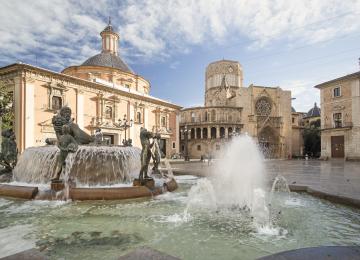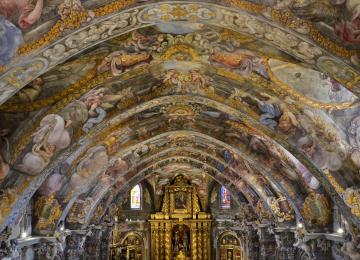La Almoina Archaeological Museum
Plaza Décimo Junio Bruto (Cónsul Romano) s/n, 46003 - València





TOURISTIC AREA: Historical center
La Almoina Museum: Valencia’s entire history on display
La Almoina Museum in Valencia is no ordinary place: vestiges of the city’s history from its founding by the Romans in the 2nd century BC to the Middle Ages have been preserved in a single space.
This creates tremendous archaeological value. In fact, it is considered one of Europe's most important sites.
La Almoina Museum is also an amazing history lesson in three dimensions: the best way to understand and imagine how this great city has evolved. It presents remains from each of its periods in such a way that you will not easily forget the events that have marked Valencia over the course of its history.
Before you visit, there are a few things you might like to know to get the most out of the experience.
A bit of history
As we mentioned, La Almoina Museum contains vestiges of Valencia's history from its establishment to the 14th century. To allow you to enjoy your visit to the fullest, we offer a summary of events over the course of this period:
In the year 138 BC, the consul Decimus Junius Brutus founded the city of Valentia. But the joy was short-lived, for in 75 BC, it fell victim to the war between Pompey and Sertorius and was sacked, leaving it with little or nothing and no one until …
In 25 BC, the Romans refounded Valentia, marking the start of its imperial period.
Five centuries later, around 500 AD, the Visigoths drove out the Romans, ushering in the Visigothic or Christian period, which lasted until the arrival of the Muslims. This came in 711 AD, when they advanced into the territory, defeating the Visigoths and taking Balansiya, as they called Valencia.
The Christians won the city back in 1238 AD, when Jaime I took Balansiya during his conquest of the territory, the beginning of the Christian era and what is now the Valencian Community.
Since then, on 9th October each year, we celebrate the entry of Jaime I into Valencia.
Having provided this historical framework, let us now look at what a visit to La Almoina holds.
What you’ll find at Valencia's La Almoina Museum
La Almoina Museum is a 2500 m2 space next to Valencia Cathedral. It is an amazing collection of archaeological remains from the historical periods we have just reviewed.
To give you an idea of the scale of this space, let us just say that in the medieval period, there was a charity centre for the disadvantaged on this spot. In fact, the Valencian word almoina means 'alms’, lending the museum its name.
When the building was demolished, a large square was revealed in the basement, and beneath this, the Roman city that Valencia once was, along with remains from later periods.
So of course, action had to be taken.
A museum complex was built between 1985 and 2005, making it possible to integrate the ruins into their environment and allow us to directly engage with them.
What will you see from the different periods?
From the foundation period – despite the fact that almost everything was destroyed in the hostilities between Pompey and Sertorius and that it was then abandoned for 50 years – there still remain the shrine to Asclepius, an horreum and some baths.
From the era of the Roman Empire, there are ruins of the curia, basilica and portico from the forum.
The Visigoths left behind the baptistery and apse of the Visigothic cathedral, along with the associated funerary tombs.
Excavations revealed part of the alcázar (fortress) from the Muslim period: a waterwheel, a patio with wash basin and a fragment of the fortification.
With the arrival of Jaime I, Balansiya became Valencia, and La Almoina was built in the same space to help the neediest following the reconquest.
Remember that by then, Muslim structures had already covered up those of the Romans and Visigoths. And so, the buildings we can still see today – including the Cathedral and Archiepiscopal Palace – were erected atop the Islamic city.
In addition to the archaeological elements, technology will help you put them together in order to create an image of life during those periods in the city’s history.
A visit to La Almoina Museum is much more
Exploring La Almoina Museum is an experience that will bring you closer than you can imagine to the soul of the city.
Entering the museum and moving along its ‘streets’ is one very important part. But the surroundings only enhance it: outside, there is a pool with a glass bottom through which the ruins are visible.
And there is more: the Cathedral and Archiepiscopal Palace frame the space, making the entire area a very inviting place for a stroll, exploring the nearby side streets.
La Almoina Museum hours: Tuesday–Saturday, 10.00am–7.00pm; Sunday and holidays, 10.00am–2.00pm.
Tickets are just €2 and free on Sundays and holidays.
So, fancy a journey through the history of Valencia?
Details
- Business schedule
-
Schedule info
Monday to Saturday, continuously from 10 am to 7 pm.
Sundays and bank holidays, 10 am to 2 pm.
-
Price
Single ticket: 2 Euros. Sundays and public holidays: free entry.
- VTC discount Free
- Century XXI
HOW TO GET THERE
Plaza Décimo Junio Bruto, Valencia, España




